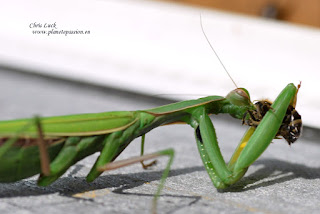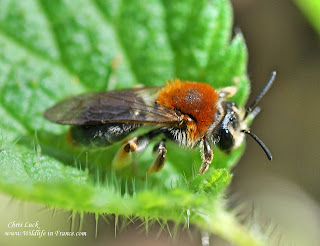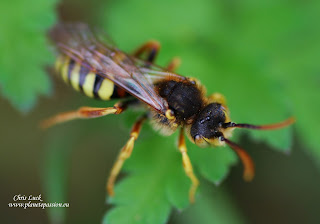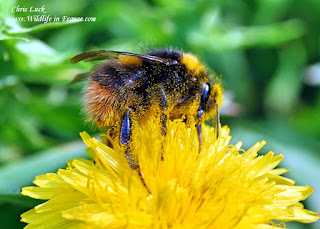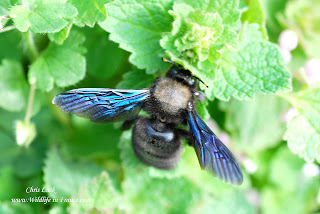Extraordinary as it may seem the French hedgehog population has declined by some two thirds during the course of the last 20 years or so with an average of some 2 million killed each year and although they are still captured illegally to be eaten by Romany people, however interesting that may be, it would be wrong to hold them responsible for something that is much closer to home for all of us.
Hedgehogs in France and their decline
Chris
A blog about French wildlife with a wide focus on French species, conservation, habitat management including keeping honey bees and honey production managed organically in a sustainable manner.
Thursday, 18 January 2018
Saturday, 28 October 2017
Gendarmes are also Red and Black bugs, (Fire bugs), in France, not just Police personnel.
Fire bug
Pyrrhocoris apterus
le Pyrrhocore or Gendarme
Many will know this highly successful common bug by the name of Gendarme or perhaps, depending on the region, names such as Suisse, Soldat, Punaise rouge, Cherche-midi or Punaise au corps de feu, all of which are widely used French vernacular names for this colourful insect.
As most people will have noticed the "gendarmes" are gregarious and as such live in colonies, which can be described as "gendarmeries", and can number several hundred or even thousands of individuals. Their Black and Red colouration apparently contains a substance that gives them some immunity from predation and as such they make no attempt to hide and even have a very pronounced propensity for collective sunbathing, hence the name of "Cherche-midi". Even in winter on a warm day a sunny stone wall or tree trunk will see them out and about.
Click on photos to enlarge
Being well equipped defensively the gendarmes are totally devoid of olfactory cells that provide the "fatal weapon" of many so-called "stink bugs" in the excretion of noxious smells when threatened.
Congregations will frequently be seen at the base of walls, the bottom of hedges and they will often be seen at the foot of trees, especially Lime trees, (Tilia), as they have a taste for the seeds. The seeds of Hollyhocks, Mallows and Hibiscus are also especially tempting for them and additionally they will eat dead and dying insects.
.
They, as with all hemipterans, are equipped with a rostrum which is a beak-like projection that can reach nearly half its body length. These mouthparts are distinctive, with mandibles and maxillae modified to form a piercing "stylet" sheathed within a modified labium.
In the case of the Fire bug the sharp needle can be used to pierce hard seeds allowing saliva to be pumped into the interior with enzymes that make the nutrition available to be sucked up as food. When not in use it is folded back under its body and as such is rarely seen or not recognised for what it is. Other true bug species may use this for killing prey or defensively.
Coupling usually takes place from April until August in France
Whatever their stage of development they cause no harm to living plants or insects and are no cause for concern to humans although there is an outside chance that one could prick you with its rostrum if handled but why would you handle one in the first place unless you are like me.
NOTE: There are quite a few other species of red and black shield bugs to be found in France
Labels:
Insects
Monday, 23 October 2017
Praying Mantis in France - Mantis religiosa
Although the vast majority of Mantis species have their homes in tropical and sub-tropical climates France plays host to a dozen species most of which are in the Mediterranean region, some quite rare and only found in the coastal band. However the one that most people are familiar with, the Praying Mantis Mantis religiosa, can be found throughout all of France Europe as far north as Denmark
Without doubt people will be drawn to their two bulbous complex eyes but like many insects they also have three small simple eyes located between them which largely go unnoticed by most people. Although called “simple” they aren’t at all simple. (Human beings have “simple” eyes see link at the end). Their triangular head has powerful mandibles and can rotate through almost 180° allowing them to remain motionless while looking around. Their vernacular name comes from the manner in which they hold their spectacular forelegs with hands joined as if in prayer. The importance of these strangely developed forelegs is to defend against attack and to grab and hold prey, never for walking although they may be used in climbing to pull themselves up or hang on. The males will also use their forelegs to hold the female during copulation. Although rarely seen they also have beautiful wings and can make short flights.
Brown Praying Mantis
Their Life Cycle is an incomplete metamorphosis, egg, stages of nymph and then adult. They reach adulthood in late summer and mating takes place in August and September when the females release what is known as an Oothecae or Egg case. This is slowly forced out by the genital valves in the form of a mousse which hardens rapidly on contact with the air. In it will be contained some 200 to 300 eggs which will remain there until the following June when the nymphs will emerge in a thin membrane from the central band running down the egg case. This is quickly shed at which stage they already look just like very tiny adults and as they grow they will shed their skin another 6 times before reaching adulthood. Their wings fully develop just before the final moult. The adults die from late October until early December depending on region and weather conditions.
Mantis releasing egg sack
Mantis eating a fly
The act of mating itself can last many hours and although it isn’t always the case the female can and will eat the much smaller male when he has served his purpose, photo below.
Female eating male following copulation
Preferred habitat is rough grassland and scrub but gardens even in towns can be equally attractive for them provided they are insecticide free.
Diet is rich and varied with prey being captured using the forelegs which are armed with a series of angled spines that prevent the prey escaping. In their initial nymph stages they will eat aphids, baby spiders and other small insects but as they grow they take larger insects, flies, butterflies, bumble bees, solitary bees, anything in fact that settles within range of their forelegs. Even instances of small birds and hatchling snakes being eaten have been recorded.
Mantis eating one of my honey bees on a hive front
One more point is that there appears to be no obvious environmental reason for some being brown and some being green, both colours will be found in the same habitat and for both sexes and they will breed with each other.
Chris
Saturday, 21 October 2017
French Honey bee swarm in August - too late to survive?
Honeybee swarms that issue from colonies that live in hollow trees, cavities in stone walls, roof spaces and such like are always of interest to me as they have invariably developed the ability to survive without all the treatments and manipulations that beekeepers generally use and to my mind these are the survivor bees we need for the future.
This little piece is about one such swarm…….
To my surprise I was called to a bee swarm on the 18th August this year which is extremely late in the season but these things do happen and after asking the caller a few questions to verify it really was a swarm of bees I prepared a ruchette, (which is a small hive or nuc box in English), popped it in the car and set off.
Sure enough, when I arrived there was the small swarm clustered close to the ground attached to an Oleander shrub about 20 metres from the persons’ house where it had come from. Remarkably the roof of the house has three separate bee colonies in it, one on each eave and one in the ridge and they have apparently been there for several years which goes some way to disproving the widely held view that left to themselves honey bees won’t nest close together – these are no more than 6 or 7 metres apart in total.
Click photos to enlarge
A small swarm at that time of year will almost certainly be a swarm that the colony has produced in addition to its main or prime swarm that will have been larger and earlier in the year. The conventional wisdom is that secondary swarms or after-swarms are issued in the first week or so following the prime swarm and contain a virgin Queen and although normally the first virgin Queen to hatch will kill the others in their cells before they hatch this isn’t always the case and exceptionally over a period of some weeks there could possibly be a 3rd, 4th or even 5th swarm all lead by a Virgin Queen if the issuing colony is severely restricted for space or genetically inclined to swarm which can apparently be the case. There are other reasons put forward for after-swarms but that isn’t really important here as this particular very small swarm had a mated Queen and didn’t issue until the 18th August, (April – June being the normal time period for swarming here).
Housing the swarm in the Ruchette was easy with a little persuasion following which I took them back to my place.
Next there is the tricky matter of giving them a fighting chance of becoming a viable colony at this late stage of the year, something they would be unlikely to have without help. When a swarm moves into its new home it has nothing, no comb, no stores and no brood. This is a period when the bees must work hard and fast in constructing comb, fetch both nectar and pollen to enable the raising of new bees. Even if conditions are good it will be nearly 4 weeks before there will be any new bees during which time the size of the colony will be diminishing as bees die. In this case that would take us to the middle of September when the season is more or less finished apart from Ivy, a few garden flowers and perhaps some flowering cover crops / green manures, phacelia, mustard, fodder radish being the most widely grown, certainly not enough for so few bees to provide themselves with winter stores.
With this in mind the following morning I immediately put a top feeder on with syrup and continued keeping it topped up every day until the beginning of October when I started giving them slightly diluted honey using a simple modification to the inner cap of the feeder by drilling some holes in it to make the honey available to the bees.
All this feeding has given the bees the ability to increase their colony size and bring the ruchette up to winter weight with stores of honey before the end of October. All I can do now hope that they will get through the winter, especially as they are from an unmanaged colony which as I mentioned at the outset tend to have good survival traits.
Fingers crossed, Chris
Labels:
Bees
Hawk moths in France - a simple guide
In the UK France
The simple list that is linked gives their names in English, Latin and French, the caterpillar food plant, annual generations and migratory status, (if any), and a link to photos & distribution for each species on Lepinet.
Chris
Labels:
Moths
Sunday, 2 July 2017
Owls in France - List of names
In France there are 9 species of Owl and unlike the UK
they have a name prefix that divides owls with visible ear
tufts from those without visible ear tufts.
It seems even
most French people are unaware of this as they only learn
the name and not the reason why. Most of these owls have
other popular names including many of which that are
local.
Full list with names in French - Latin - English can be found here in PDF format you can save.
Chris
Thursday, 23 March 2017
Spring bees in France - solitary and bumble
Living where we do it's highly unlikely that I will see anything but the most common species of either solitary bees or bumble bees and even those are under increasing pressure as almost all the available land surface is constantly plowed for the production of cereals and crops for the animal feed industry. It's mainly the ground nesting species that are suffering although increasingly people also spray insecticides on the solitary species that nest in the outside walls of their houses or block the tiny holes and spaces they use. Many people also spray ground nesting bees in their gardens but I'm sure in most cases this isn't malicious but simply because people don't know what they are or the important role they play in our environment.
Of course even the common species are a joy to me and I see a reasonably large number at our place. Here are a few I've managed to spot so far this spring which given the rather poor weather it isn't too bad.
Click on or tap photos to enlarge.
Male Andrena fulva, Tawny mining bee, not managed to get a decent photo of a female yet, perhaps when the rain stops.
Female Andrena haemorrhoa, Early or Red tailed mining bee. Females of this species are easily identified by the combination of a foxy brown thorax and foxy brown tip to the tail.
Female Andrena nitida, Grey patched mining-bee.
Andrena gravida, Banded or white bellied mining bee. Probably a female judging by size alone and what a stunningly pretty bee.
Male Andrena cineraria, Ashy mining bee. A species that may be benefiting from the extensive cultivation of Oil seed rape in the region, (or in much of France), as only takes pollen from certain Cruciferous plants, (mustards, rapes,
charlocks etc).
The above Ashy mining bee was found about 20cm, (8 inches), from this Nomada lathburiana, Lathbury's Nomad which is a "cuckoo bee" or cleptoparasite for the Ashy mining bee. The Nomada female detects incomplete host cells which are still open and being provided with food and places her egg in it. When the Nomada hatches it will destroy the egg or the larva of the Andrena species and consume the provisions.
Male Anthophora plumipes, Hairy footed flower bee having a few moments rest from feeding and trying to defend a patch of violets from other males. Haven't seen any females yet this year.
Queen Bombus pratorum, Early bumblebee or early-nesting bumblebee.
Xylocopa violacea, Carpenter bee. Always plenty of these here, (just let one out of the house that came down the chimney). A docile bee that frightens some people that don't know what they are.
Now when is that rain going to stop so I can go outside and get on with the garden, (and play).
Labels:
Bees
Subscribe to:
Comments (Atom)














